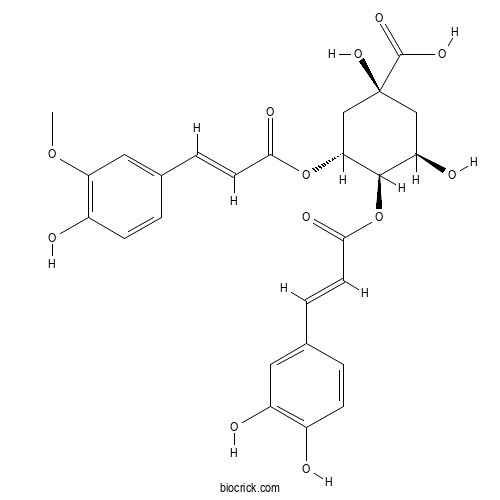3-Feruloyl-4-caffeoylquinic acidCAS# 96990-65-7 |

Quality Control & MSDS
3D structure
Package In Stock
Number of papers citing our products

| Cas No. | 96990-65-7 | SDF | Download SDF |
| PubChem ID | 92135801.0 | Appearance | Powder |
| Formula | C26H26O12 | M.Wt | 530.48 |
| Type of Compound | N/A | Storage | Desiccate at -20°C |
| Solubility | Soluble in Chloroform,Dichloromethane,Ethyl Acetate,DMSO,Acetone,etc. | ||
| Chemical Name | (1S,3R,4R,5R)-4-[(E)-3-(3,4-dihydroxyphenyl)prop-2-enoyl]oxy-1,3-dihydroxy-5-[(E)-3-(4-hydroxy-3-methoxyphenyl)prop-2-enoyl]oxycyclohexane-1-carboxylic acid | ||
| SMILES | COC1=C(C=CC(=C1)C=CC(=O)OC2CC(CC(C2OC(=O)C=CC3=CC(=C(C=C3)O)O)O)(C(=O)O)O)O | ||
| Standard InChIKey | SDMADMBVKYOYQN-CSPRBKSFSA-N | ||
| Standard InChI | InChI=1S/C26H26O12/c1-36-20-11-15(3-7-17(20)28)5-8-22(31)37-21-13-26(35,25(33)34)12-19(30)24(21)38-23(32)9-4-14-2-6-16(27)18(29)10-14/h2-11,19,21,24,27-30,35H,12-13H2,1H3,(H,33,34)/b8-5+,9-4+/t19-,21-,24-,26+/m1/s1 | ||
| General tips | For obtaining a higher solubility , please warm the tube at 37 ℃ and shake it in the ultrasonic bath for a while.Stock solution can be stored below -20℃ for several months. We recommend that you prepare and use the solution on the same day. However, if the test schedule requires, the stock solutions can be prepared in advance, and the stock solution must be sealed and stored below -20℃. In general, the stock solution can be kept for several months. Before use, we recommend that you leave the vial at room temperature for at least an hour before opening it. |
||
| About Packaging | 1. The packaging of the product may be reversed during transportation, cause the high purity compounds to adhere to the neck or cap of the vial.Take the vail out of its packaging and shake gently until the compounds fall to the bottom of the vial. 2. For liquid products, please centrifuge at 500xg to gather the liquid to the bottom of the vial. 3. Try to avoid loss or contamination during the experiment. |
||
| Shipping Condition | Packaging according to customer requirements(5mg, 10mg, 20mg and more). Ship via FedEx, DHL, UPS, EMS or other couriers with RT, or blue ice upon request. | ||

3-Feruloyl-4-caffeoylquinic acid Dilution Calculator

3-Feruloyl-4-caffeoylquinic acid Molarity Calculator
| 1 mg | 5 mg | 10 mg | 20 mg | 25 mg | |
| 1 mM | 1.8851 mL | 9.4254 mL | 18.8509 mL | 37.7017 mL | 47.1271 mL |
| 5 mM | 0.377 mL | 1.8851 mL | 3.7702 mL | 7.5403 mL | 9.4254 mL |
| 10 mM | 0.1885 mL | 0.9425 mL | 1.8851 mL | 3.7702 mL | 4.7127 mL |
| 50 mM | 0.0377 mL | 0.1885 mL | 0.377 mL | 0.754 mL | 0.9425 mL |
| 100 mM | 0.0189 mL | 0.0943 mL | 0.1885 mL | 0.377 mL | 0.4713 mL |
| * Note: If you are in the process of experiment, it's necessary to make the dilution ratios of the samples. The dilution data above is only for reference. Normally, it's can get a better solubility within lower of Concentrations. | |||||

Calcutta University

University of Minnesota

University of Maryland School of Medicine

University of Illinois at Chicago

The Ohio State University

University of Zurich

Harvard University

Colorado State University

Auburn University

Yale University

Worcester Polytechnic Institute

Washington State University

Stanford University

University of Leipzig

Universidade da Beira Interior

The Institute of Cancer Research

Heidelberg University

University of Amsterdam

University of Auckland

TsingHua University

The University of Michigan

Miami University

DRURY University

Jilin University

Fudan University

Wuhan University

Sun Yat-sen University

Universite de Paris

Deemed University

Auckland University

The University of Tokyo

Korea University
- β-Sitosteryl acetate
Catalog No.:BCX1133
CAS No.:915-05-9
- Tetraacetylphytosphingosine
Catalog No.:BCX1132
CAS No.:13018-48-9
- L-Guluronic Acid Sodium Salt
Catalog No.:BCX1131
CAS No.:15769-56-9
- Ostruthine
Catalog No.:BCX1130
CAS No.:148-83-4
- Agigenin
Catalog No.:BCX1129
CAS No.:55332-76-8
- Salidroside pentaacetate
Catalog No.:BCX1128
CAS No.:39032-08-1
- 2,3,4,6-tetraacetate Salidroside
Catalog No.:BCX1127
CAS No.:28251-63-0
- (-)-Epitaxifolin
Catalog No.:BCX1126
CAS No.:114761-89-6
- Zymosterol
Catalog No.:BCX1125
CAS No.:128-33-6
- Jaligonic acid B
Catalog No.:BCX1124
CAS No.:2375176-78-4
- Monensin B
Catalog No.:BCX1123
CAS No.:30485-16-6
- Beta-Tomatine
Catalog No.:BCX1122
CAS No.:17406-46-1
- Avenanthramide B
Catalog No.:BCX1135
CAS No.:108605-69-2
- Avenanthramide A
Catalog No.:BCX1136
CAS No.:108605-70-5
- Ganosporeric acid A
Catalog No.:BCX1137
CAS No.:135357-25-4
- N-methyltyramine
Catalog No.:BCX1138
CAS No.:370-98-9
- 3α-Hydroxymogrol
Catalog No.:BCX1139
CAS No.:1343402-73-2
- Ligustrosidic acid
Catalog No.:BCX1140
CAS No.:96382-89-7
- Presenegenin
Catalog No.:BCX1141
CAS No.:2163-40-8
- Hydroxypropyl tetrahydropyrantriol
Catalog No.:BCX1142
CAS No.:439685-79-7
- Euphornin
Catalog No.:BCX1143
CAS No.:80454-47-3
- Reptoside
Catalog No.:BCX1144
CAS No.:53839-03-5
- Jaligonic acid
Catalog No.:BCX1145
CAS No.:51776-39-7
- 24(28)-Dehydroergosterol
Catalog No.:BCX1146
CAS No.:29560-24-5
UHPLC-ESI-QqTOF-MS/MS characterization of minor chlorogenic acids in roasted Coffea arabica from different geographical origin.[Pubmed:29974575]
J Mass Spectrom. 2018 Sep;53(9):763-771.
Chlorogenic acids are relevant coffee quality markers, taste, and aroma precursors as well as important bioactive compounds. A number of mono-acyl, di-acyl, and tri-acyl quinic acid isomers were found in green coffee beans, being mono-caffeoyl, mono-feruloyl, mono-p-coumaroyl, and di-caffeoylquinic acid isomers considered as quantitatively major compounds. Roasting process increases the chemical complexity of coffee by inducing the formation of a number of lactones (quinides), shikimates, and other chlorogenic acids derivatives. So far, little attention has been paid in characterizing minor chlorogenic acids and derivatives in roasted Coffea arabica, also known as Arabica. In the present work, roasted C. arabica samples from different geographical origins (Brazil, Colombia, Costa Rica, Ethiopia, Guatemala, and India) were characterized by UHPLC-ESI-QqTOF-MS/MS. Several minor chlorogenic acid isomers were identified. In particular, HR-MS/MS provided putative identification of four dimethoxycinnamoyl-quinic acid derivatives, such as 4-dimethoxycinnamoylquinic acid, 4-dimethoxycinnamoyl-3-caffeoylquinic acid, 3-dimethoxycinnamoyl-4-feruloylquinic acid, 4-dimethoxycinnamoyl-5-feruloylquinic acid, and two caffeoyl, feruloyl quinic acid derivatives (3-caffeoyl-4-feruloylquinic acid and 3-Feruloyl-4-caffeoylquinic acid). To our knowledge, these compounds were found in roasted Arabica coffee for the first time, and their presence is independent on the different geographical origins examined.


